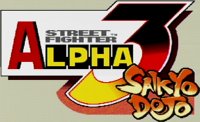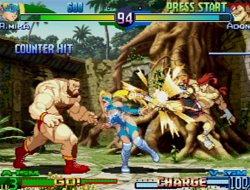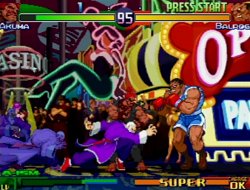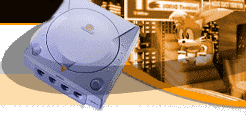| |
Street Fighter Alpha 3
It's kinda like Phil Hartman: late but great. - Review By BenT
 Capcom... what an odd company. I must admit, I have a love/hate relationship with them. The love part came about because of their great original games, classic stuff like Mega Man 2, Strider, Bionic Commando, and Street Fighter 2. They have newer games that rock too, like Power Stone, Tech Romancer, Puzzle Fighter, and Resident Evil. And we can't forget those 2D shooters they're dutifully bringing to the Dreamcast, either -- rock! Finally, it doesn't hurt that they're stalwart Dreamcast supporters... we can't argue with that.
Capcom... what an odd company. I must admit, I have a love/hate relationship with them. The love part came about because of their great original games, classic stuff like Mega Man 2, Strider, Bionic Commando, and Street Fighter 2. They have newer games that rock too, like Power Stone, Tech Romancer, Puzzle Fighter, and Resident Evil. And we can't forget those 2D shooters they're dutifully bringing to the Dreamcast, either -- rock! Finally, it doesn't hurt that they're stalwart Dreamcast supporters... we can't argue with that.
But then there's also the dark side of Capcom, which we can refer to as the sequel factory. They're the ones responsible for Mega Man 6 on the NES. And Mega Man X4 on the SNES (and the PSX, and the Saturn...). And Resident Evil 3 on the PSX. And the dozen or so variations of Street Fighter that have appeared over the years. In short, any time Capcom makes a good game (or a mediocre one, in the case of Rival Schools or Star Gladiator) they proceed to drive the potential franchise into the ground by grinding out sequel after repetitive sequel. In fact, I have to wonder if Capcom's sequels now outnumber their original games; I wouldn't be surprised. In any case, I've grown to detest this behavior over the years, as it often seems to produce games that are more average than enjoyable.
Today we have yet another Capcom sequel before us: the long-awaited Dreamcast version of Street Fighter Alpha 3. A lot of mystery has surrounded the American debut of this game, which was originally supposed to appear shortly after launch. Alpha 3 was one of the Japanese Dreamcast's earliest fighters, so why has it taken until mid-2000 to appear here? The original excuse was that Capcom wanted to add online fighting to the title. Unfortunately, they then announced that this fell through, and that the game would have no online capabilities. Then the waiting began. The release date was pushed back, repeatedly. 2D fighting fans groaned in frustration; would this game ever make it out? And just what was the problem, anyway? It turns out that Capcom and Sega were bickering over the nature of the game's online components -- Capcom wanted to support online fighting via their own servers (as they do in Japan), but Sega demanded that they support the as-yet-unoperational SegaNet. The situation was finally resolved last week, when to everyone's surprise the game went on sale at Best Buys across the country. Why it was first released at Best Buy, of all places, is unknown. I mean, that's just darn strange. I'm not going to obsess over it, though; after all, the game is here, just begging for us to review it. And so I shall.
The Good

Dramatic Battle. I can't play R.Mika at all, so she died shortly after this pic was taken. |
Variety is the order of the day in Street Fighter Alpha 3, as this game has more modes than you can shake a VMU at. Arcade, Versus, Team Battle, Training, World Tour, Network, Survival, Dramatic Battle, Versus Dramatic Battle, and Final Battle all await your playtime. Some modes (like Arcade and Versus) are self-explanatory, but I'll list off the others. Dramatic Battle allows you to fight a series of computer opponents with a teammate, who is controlled by either the computer or a friend. Versus Dramatic Battle allows three players to fight 2 on 1. Final Battle skips you ahead to the last stage of Arcade mode, so you can defeat M.Bison and see your character's ending. Network is not as interesting as it sounds -- it merely lets you download new "opponents" from a Capcom server, such as a hyper-strong Chun-Li. Unfortunately they're just for practice, and take up a surprisingly huge chunk of your VMU. Finally, World Tour Mode allows you to follow a fighter as they journey across the globe, earning experience points and gaining in abilities along the way. Once the final battle of World Tour is completed, this powered-up fighter can be exported to the game's other modes.
Street Fighter Alpha 3 has more fighters than just about any other 2D fighting game yet released in the US. Every character from the Street Fighter II and Street Fighter Alpha series is represented here, so you can rest assured that your favorites are present. It doesn't stop there, though. Alpha 3 has taken an old SNK feature and done it one better: there are now multiple versions of each character, some of which play quite differently from each other. This is implemented via the "'ism" system, which effectively gives you three versions of each fighter. An X-ism character plays like someone from Super Street Fighter II Turbo; they give out and take more damage than the other 'isms, have a slowly-filling super bar, a single super combo, and none of that fancy air blocking stuff. A-ism is the "standard" type of character, akin to someone from Street Fighter Alpha: they have air blocking, multiple super combos, air recovery, a 3 level super meter, and alpha counters. Finally there's V-ism, which is probably the oddest variety. V-ism characters do less damage and have a two-level super meter which allows them to perform custom combos (you know, those crazy spaz-fests from Street Fighter Alpha 2). Other than that they're similar to A-ism fighters, except that they have no super combos.

Balrog is no match for the combined assault of my Gen and the computer's Akuma. |
Believe it or not, there's more. Before you select your 'ism, you can also choose one of three other modes which will modify your character (or, you can elect to skip this step and just go with a plain 'ism). Classic mode is basically a fourth 'ism; it's similar to X-ism, but even more basic. Classic characters have no super or guard meter, or, well... anything. We're talking pure Street Fighter 2 gameplay, or as close as you're going to get in Alpha 3. Mazi mode allows your character to dish out double damage, but they also lose life twice as fast. Worse, if they lose a single round the match is over -- quite the disadvantage. Finally, Saikyou mode is pretty much a joke. Saikyou fighters do less damage, their guard meter is short, they can't two-in-one, and they get dizzied much more easily. Needless to say, Saikyou mode is for experts only. The variety introduced by the 'ism and mode system is unprecedented. While it's not quite the same as having hundreds of unique characters, it's certainly a step in that direction, and adds a lot to the game's long-term playability.
The game plays similarly to the previous Street Fighter Alpha games, except that there is now a much larger emphasis on air juggling. As I just mentioned, the 'ism and mode systems add a lot to the strategic depth. For example, Cody is a rather offensive character in X-ism and A-ism, but in V-ism he gains a unique dodge move that makes him a defensive wonder. Sure, all Street Fighter games allow you to play a character as you choose, but the 'ism system allows you to custom-tailor the fighter to your specific gameplay style. Very cool.
As you'd expect, the control is as tight as ever. Unfortunately, it typically follows that the game is a bear to play with the standard Dreamcast controller. The D-Pad just sucks too much, so you have two choices: invest in a decent joystick, or purchase a more suitable control pad. I haven't used a joystick since my near, dear NES Advantage gave up the ghost, so I went with the ASCII Pad FT (Fighting Type). This pad duplicates the Saturn's sweet six-button setup with a fair amount of success, and is pretty comfortable. You can find it at any decent import shop. If you want to stick to Wal-Mart, the Mad Catz Dreampad is a half-decent fighting controller, although your mileage may vary.
Next: More Good, Some Bad, and The Final Word

|

